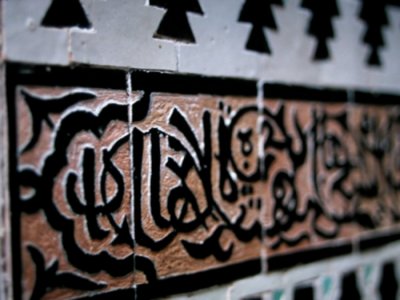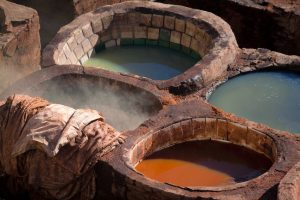Fes is a city of over 1.3 million people, of which about 450,000 people live in the old medina – the walled city. For those who have never been to Morocco or visited an old town such as this – its unlike any western town on the planet. The medina area is truly like stepping back in time.

Taken at the oldest university in Fes, which is now crumbling away
Fes is one of the largest medieval type cities still in existence. At first glance the buildings of Fes all blend together because they are all white or shades of dark – it is interesting to note that colored buildings in this town are almost nonexistent (which is completely different then Chefchouen as an example). The reason for this is that religiously what is “important” is to be found inside – hence the outside of the homes are very drab, dull and unimpressive.
However, as soon as you enter some of the these homes – wow! What tile work, mosaics and pride the people take in their homes. There is one thing that alerts you to the fact that you are looking at a 21st century city; almost every house displays a round satellite dish on their rooftop. It is interesting to note that all of these satellite dishes look exactly the same as they are all obviously from the same company. There are thousands of these spread across Fes.
In the medina ways of life are very similar to how they have been for hundreds upon hundreds of years. Cars are not allowed within its walls for obvious reason – most of the streets are merely pathway sized and for the most part are too narrow for vehicles.
One is lucky to see a motor scooter inching its way through the narrow streets trying to wind its way through the crowds. Men with mules roam the streets in the early morning – they are very effective as the towns garbage collectors.
Century old crafts and tile making skills are still used today. Individual pieces of tile which form the basis for the incredible mosaics seen in Fes are still crafted entirely by hand. In certain parts of old town Fes one can see men huddled in front of rocks chipping at tile with iron tools – slowly and painstakingly crafting each unique piece of tile.
There are three distinct parts of Fes: the central medina, the Royal Palace, and the “new town” located completely outside of the medina walls. Culturally the most interesting area is the medina. Over 360 mosques are contained within its walls and on Fridays at the largest mosque over 2000 people will gather at any one time to pray.
 The core of the medina are the artisan craft shops including clothing (a good selection of jalabas – a robe like the ones worn by the Jedi Knights in the Star War Series), rugs, leather, and other arts and crafts.
The core of the medina are the artisan craft shops including clothing (a good selection of jalabas – a robe like the ones worn by the Jedi Knights in the Star War Series), rugs, leather, and other arts and crafts.
Its quite easy to become lost in Fes – with its numerous winding streets – getting lost is of course a bit of the charm as you don’t know what you will end up finding. This is a good way to spend a day in Fes, getting “lost” in the medina.
Taxis in Fes are mostly small red cars. They should have meters in them – the train station is about a 15 – 20 minute ride from the medina. The taxis always charge more for night rides.
Tanneries are a must visit. These are located in the north eastern part of the medina right at the edge of town and contains about a hundred vats full of colored liquids used for soaking animal leather skins to change their colors.
The vats are made with mud and some are rimmed with tile. The morning is the best time to visit the tanneries as the vats are still filled with the colored liquid. The liquid is composed of urine, fish oils, animal fats and several chemicals. The stench is certainly worse on a warm day. Visitors can walk up stairs that lead to “lookouts” over the tanneries – including views outside of the medina. A small admission is charged to visitors entering the tanneries.
From the rooftops or from other high vantage points in Fes one can sometimes see a spray of colors lining the distant hills. These colors are from the rugs that have been dyed in the tanneries and then spread out to dry.
Leave a Reply